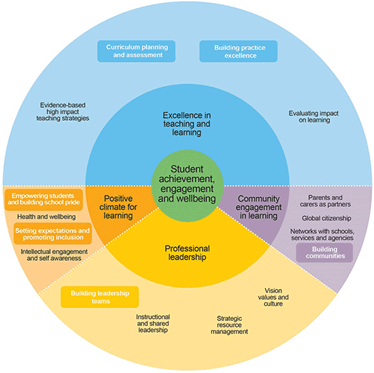
By Jane Langley
EDITION #2 – How do I built great relationships?
Published – 6th March 2019

Teacher-student relationships require conscious effort and planning.
Strong and supportive relationships between teachers and students are fundamental to student success at school. The research shows that ‘When people feel positive about a learning situation, chemicals called endorphins and dopamine become active. This helps students remain attentive, interactive and likely to remember what he or she experiences.’ (Sousa 2009).
Students will be more engaged in tasks, academically and behaviourally, and are more likely to learn. It is not surprising that constructive teacher-student relationships have a significant and positive impact on student academic results.
As a graduate teacher it is essential to know that developing teacher student relationship requires conscious effort and planning. Building strong teacher-student relationships built on mutual respect doesn’t happen by chance. It requires being mindful of the things you say, do and think every day. It is not about doing big things, but rather, it is about being conscious of the little things that you do every day that make a difference. A colleague, Bill Hansberry, describes these as the ‘One Percenters’ i.e. the daily actions that collectively add up to be big things.
Techniques that build relationships
You may be the only person who notices and interacts positively with that student on that day.
When students are asked to describe the good teachers in a school, the ones they like, they will typically say ‘the teacher that smiles, says hello and knows my name’. This simple strategy has great power and speaks volumes in an interaction that only takes a few moments. Our smiles say we have a warm nature, the ‘hello’ says I noticed you, and using a name means I know who you are.
This is the key understanding when I meet and greet the students at my classroom door. Taking the time to present students with a warm welcome makes a significant difference before the lesson has even begun. Apart from making students feel good and helping set the classroom tone, I also know that for many students I may be the only person who notices them and interacts positively with them throughout the day.
I also know that these interactions can be strengthened even further by adding a question, statement or compliment, such as:
- How did your netball/football game go?
- I noticed you did well in your spelling test
- I liked the way you packed up without having to be asked
Strategies for building strong student relationships are not isolated to the classroom or to the students we teach. Building strong teacher relationships can happen everywhere, across the school and with all students, because ensuring students feel happy, safe and connected to school is the responsibility of everyone.
Being active on yard duty is one of the key strategies for building relationships with all students. Some teachers view yard duty as a time to police the yard focusing only on correcting inappropriate behaviour. This approach misses a powerful opportunity to build connections with young people. Whilst keeping the school yard safe is an important part of our role, it is also a time to build relationships with all students. This is the perfect time to show an interest in students. Whilst on yard duty take the time to stop and chat with the various groups. The youngest children love to show you their newest accomplishments and quick pop-ins to small groups sitting and chatting is often helpful.
Teachers create significant relationships with students
Teachers who have a desire to help students learn also have high expectations for behaviour.
The Search Institute has developed a list of 40 Developmental Assets that enable young people to be successful in school and life. The Developmental Assets are research-based, positive qualities that influence young people’s development, helping them to become caring, responsible, and productive adults. Amongst these assets is the importance of having a significant relationship with an adult. Whilst this is something teachers already knew from experience; the Search Institute has unpacked the key elements of the relationship. In the research they describe what a significant relationship with an adult looks like.

Teachers who understand the balance, have a desire to help students learn and have high expectations of behaviour. Yet they also value their students as people and take an interest in their lives. These teachers are firm but fair. They develop relationships built on mutual trust which allows them to challenge students academically and socially. These teachers provide their students with strong guidance and know how to speak respectfully, firmly and confidently to achieve positive results. A common error many teachers make in developing positive teacher relationships with students is that they confuse a positive teacher-student relationship with being the student’s friend.
An evidence-based framework for evaluating your school climate
A positive climate for learning is one the four state-wide priorities.

The Department of Education and Training’s (the Department) frameworks, policies and documents recognise the important link between wellbeing and learning outcomes. The Department’s Framework for Improving Student Outcomes (FISO) has made ‘a positive climate for learning’ one the four state-wide priorities for creating an effective school culture.
The model acknowledges that developing a positive school climate has a significant impact on a students’ motivation to learn and achieve, as well as student health and wellbeing. The model contains a clear statement that each school has a responsibility to ‘ensure that each student has at least one ongoing relationship with a member of staff, such as a home group teacher’. Having these relationships is critical to a students’ motivation to learn and achieve.
A practical strategy to create a positive climate: Checking-in
When modelling listening without judgement, we are teaching respect and empathy.
I have found a simple yet effective strategy for building a positive climate and making connections with and amongst students in the classroom, is through establishing a Check-in process.
The Check-in process starts with students sitting in a circle (they can stay at their desks if the space does not allow for a circle).
A talking stick is then passed around the circle and students are invited to share with the grade. Typically, I direct students to respond with ‘good morning’ or ‘something I want to share with the grade’. It is important that this time is not a ‘bring and brag’, but rather a time for students to share things that are happening in their lives that they think are important, and appropriate, for the class community to be aware of. This may be an upcoming birthday, a sick dog, a trip that they may be excited or worried about or something connected with the learning. These little snippets of information provide an insight into the student’s life outside the school gates, but also allows us to track how the student may be travelling on any particular day and what support they may need to manage emotions, friendships and learning tasks.
During this process it is important to listen without judgment. I focus on acknowledging each person’s contribution and then moving on. This usually looks like saying a simple ‘thank you’, followed by the student’s name, and then turning my attention to the next person in the circle. This models respect and acceptance while also keeping things moving.
A daily or weekly Check-in circle allows you to gain a snapshot of the emotional status of your students and gain an insight into what is happening in a student’s world. The Check-in also develops prosocial skills such as active listening and turn taking. Through modelling listening without judgement, or allowing students to pass, we are also teaching values such as respect and empathy. Through the Check In we are developing a safe classroom built on trust, cooperation and community.
The activity can be adapted to enable you to gather a quick snapshot of how students are feeling including:
- Placing feeling cards in the middle of the circle
- Asking students to rate their morning out of 10
- Asking students to consider if they were a colour (or the weather) what colour would they be.
The challenges of building student relationships
There are students who have learnt it is safer to keep people at a distance.
Despite our best efforts there are some students with whom it can be difficult to build a respectful and trusting relationship. These are usually the students who have learnt that it is safer to keep people at a distance. These students may have the challenge of previous poor relationships and mistrust to overcome. As hard as it may be at times, it is critical that we help these students feel safe at school and model positive relationship interactions. For many of these students, school may be the only place where this occurs, and teachers the only people who model healthy, supportive relationships. Building relational trust involves simple daily interactions such as smiling, getting to know your students and sharing snippets of your own life with them.
When this all seems too hard you could implement the Two by Ten Strategy. This means identifying one or two students who you are finding it difficult to build a connection with. For ten consecutive days, invest two minutes each day to talk to that student about anything she or he wants to talk about. Start with small gains and build on this. It may help to remember a phrase from a mentor of mine, it’s about ‘light pressure applied relentlessly’.
Top takeaways for graduate teachers
Here is the list of One Percenters that I reflect on at the end of each day.
In my teaching today, did I:
- Smile, say hello and use the student’s name?
- Have conversations with a student when on yard duty?
- Check In with the students in my classroom?
- Take an interest and listen to a student’s story?
- Offer words of encouragement and praise efforts?
Then I set goals for the next day starting with what can I do tomorrow to widen and strengthen my relationships with the students in my classroom as well as all the other students in the school community.
References
Department of Education and Training 2018, ‘Framework for Improving Student Outcomes’ viewed 27 October 2018, https://www.education.vic.gov.au/school/teachers/management/improvement/Pages/improvement-model.aspx
Search Institute 2018, ‘40 Developmental Assets’, viewed 27 October 2018, https://www.search-institute.org/
Sousa, D. 2009, ‘Brain-Friendly Learning for Teachers’ viewed 27 October 2018, http://www.ascd.org/publications/educational_leadership/summer09/vol66/num09/Brain-Friendly_Learning_for_Teachers.aspx
